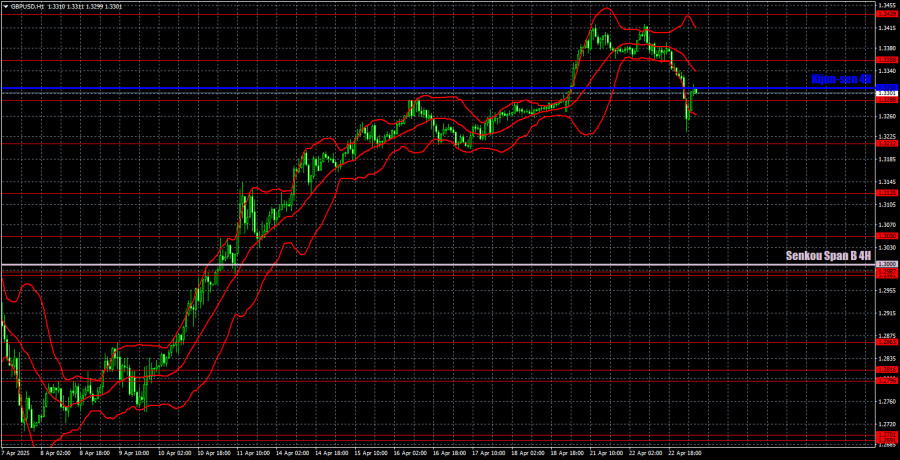GBP/USD 5-Minute Analysis
On Tuesday, the GBP/USD currency pair showed very low volatility and a general lack of interest in trading. While the euro traded with a noticeable decline, the British pound mostly stood still. A significant drop only began during the night. Just take a look at the movements over the past two weeks! During this period, pullbacks and corrections were almost absent. Even with the strongest fundamental and macroeconomic background favoring the British currency, we would not expect such a one-sided move. In our view, this only means one thing—there is currently no logic in the market movements. The market receives new headlines about a possible escalation in the trade war and may sell the dollar for weeks based on a single news item. When the next phase of the dollar's decline will end is impossible to predict. Technical levels are often ignored. Chaos still reigns in the currency market and financial markets more broadly.
As we've said before, the uptrend is visible from a mile away, yet it's impossible to form a proper trendline—or a trend channel. The pair pulled back yesterday, but who can expect a substantial decline right now? Tomorrow, Donald Trump may announce new sanctions or increase tariffs on China to 500%. What market reaction can be expected?
Throughout the past day, the price rebounded several times from the 1.3358 level but never managed to move more than 20 pips in the desired direction. By the end of the day, it returned to that level again and broke below it. Afterward, during the Asian session, it dropped about 100 pips.
COT Report
COT (Commitments of Traders) reports on the British pound show that sentiment among commercial traders has been constantly shifting over recent years. The red and blue lines, representing net positions of commercial and non-commercial traders, frequently intersect and are usually close to the zero mark. This is still the case now, which indicates a roughly equal number of long and short positions.
On the weekly timeframe, the price first broke through the 1.3154 level, then overcame the trendline, returned to 1.3154, and broke it again. The breach of the trendline would typically suggest a high likelihood of further pound declines. However, we continue to see the dollar falling due to Donald Trump. Therefore, trade war news may keep pushing the pound even higher, regardless of the technical picture.
According to the latest COT report on the British pound, the "Non-commercial" group closed 6,000 BUY contracts and opened 4,700 SELL contracts. As a result, the net position of non-commercial traders has declined for the third consecutive week (-10,700 contracts), yet this hasn't had any meaningful impact on price movement.
The fundamental background still doesn't support long-term buying of the British pound, and the currency has realistic chances of continuing its long-term downtrend. The pound has risen sharply in recent months, but the reason is apparent: Trump's policy actions.
GBP/USD 1-Hour Analysis
On the hourly timeframe, the GBP/USD pair has shown a strong "rally" after nearly a month of sideways movement, followed by a sharper drop and now another even stronger rally, which has continued for two weeks. The British pound has posted substantial gains, although it can take no real credit. The entire upward movement of the pound is due to the decline of the dollar, triggered by Donald Trump. And that process isn't over yet. As such, chaos, panic, and confusion continue to dominate the market, while logic and consistency in movements are nowhere to be found.
For April 23, we highlight the following key levels: 1.2691–1.2701, 1.2796–1.2816, 1.2863, 1.2981–1.2987, 1.3050, 1.3125, 1.3212, 1.3288, 1.3358, 1.3439, 1.3489, 1.3537. The Senkou Span B line (1.3000) and Kijun-sen (1.3310) may also be signal sources. A Stop Loss is recommended to be moved to breakeven if the price moves 20 pips in the right direction. The Ichimoku indicator lines may shift throughout the day, which should be considered when determining trading signals.
On Wednesday, the UK and the US are scheduled to release April business activity indices, which could affect trader sentiment. However, the market may not react to these reports—or we might not even notice any market reaction at all.
Illustration Explanations:
- Support and Resistance Levels (thick red lines): Thick red lines indicate where movement may come to an end. Please note that these lines are not sources of trading signals.
- Kijun-sen and Senkou Span B Lines: Ichimoku indicator lines transferred from the 4-hour timeframe to the hourly timeframe. These are strong lines.
- Extreme Levels (thin red lines): Thin red lines where the price has previously bounced. These serve as sources of trading signals.
- Yellow Lines: Trendlines, trend channels, or any other technical patterns.
- Indicator 1 on COT Charts: Represents the net position size for each category of traders.














